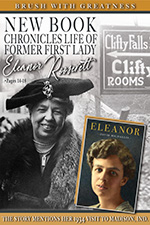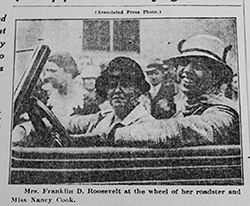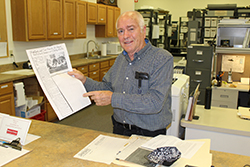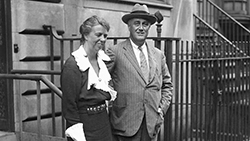




Brush With Greatness
New book chronicles life
of First Lady Eleanor Roosevelt
The story mentions her 1934 visit to Madison, Ind.
 |
December 2020 Cover |
(December 2020) – A new book recently published by Simon & Schuster about First Lady Eleanor Roosevelt, wife of President Franklin D. Roosevelt, chronicles her life story. Portraying her as a leader in her own right who was involved in numerous humanitarian causes throughout her lifetime, New York-based author David Michaelis paints Eleanor as a real person – one with whom people could easily identify and place their faith in during some of the darkest days in American history.
“When I was a child, my mom worked for Mrs. Roosevelt,” said Michaelis during a November telephone interview. In 1959, Michaelis’ mother, Diana Tead Michaelis, was a TV producer and worked with Roosevelt on “Prospects of Mankind,” the former First Lady’s public television show.
What Michaelis remembers is that he “was trying to get a stick of gum off the First Lady, off my mother’s boss. She was fresh out of Juicy Fruit.”
What he took away and remembers feeling “is this
 |
|
feeling of a person from whom goodness was literally pouring forth from these eyes that were alive and radiant.” What he believed was that she “wanted to be available.” For everyone.
Michaelis, 63, has penned a 698-page biography of whom many consider to be America’s greatest First Lady. He has previously written highly acclaimed biographies of cartoonist Charles Schulz and American artist and illustrator N.C. Wyeth.
“The magic for me (in writing the book) was in revealing she was just a person,” he said. Whether Eleanor believed it herself or not, she was an extraordinary person who was able to relate to everyone on a common level – a charm much needed in the turbulent years of her husband’s presidency.
Michaelis began his career as a magazine journalist. “I was a business writer for Manhattan, Inc. in the ’80s.” Next he tried his hand at fiction and non-fiction, “then I found biography.” The latter was clearly his niche.
When Michaelis embarked upon this daunting task of writing a new biography of Eleanor Roosevelt a decade ago, he felt he had to “free the story of her life, the person she was.”
He said “there are a million documents in the F.D.R. Presidential library in Hyde Park (N.Y.),” and although he
 |
|
did not peruse every one, he did spend countless hours searching for the real Eleanor Roosevelt. In doing so, he realized he had to also research her husband and uncle, Theodore Roosevelt, both of whom were U.S. presidents.
He visited the Theodore Roosevelt archives in Cambridge, Mass., and spent time in the “old-fashioned archives at Harvard.” He “got very involved in the Theodore Roosevelt family and learned a lot,” realizing it was all necessary research to further explore Eleanor and understand the complex woman who was first lady.
Eleanor Roosevelt’s climb to the top
Anna Eleanor Roosevelt was born on Oct. 11, 1884, in New York City. Her father, Elliott Roosevelt (1860-1894), was the younger brother of future President Theodore Roosevelt. Her mother, Anna Hall (1863-1892), was from a wealthy New York family.
But her childhood wasn’t an idyllic one. Roosevelt’s father was an alcoholic, and her parents’ marriage was troubled. Eleanor’s mother died of diphtheria in 1892, and her father died less than two years later. “Eleanor’s father was a mystery in the way his life has been told in previous volumes,” said Michaels.
She and her two younger brothers, Elliott Roosevelt Jr. and Gracie Hall Roosevelt, were raised by their grandmother, Mary Ludlow Hall, in Manhattan and Tivoli, N.Y. Eleanor was perceived as an awkward, serious child and educated by private tutors until age 15. She was sent to Allenswood Academy, a school for girls in England where she excelled under the mentorship of the school’s headmistress, Marie Souvestre.
Her formal education ended at age 18 when she returned to New York City to make her social debut at the Waldorf-Astoria Hotel. She then became actively involved with social reform work and volunteered as a teacher for impoverished immigrant children at Manhattan’s Rivington Street Settlement House. She also joined the National Consumers’ League, believing in their mission to end unsafe working conditions and labor practices in factories and other businesses.
 |
Michaelis |
On March 17, 1905, 20-year-old Eleanor married Franklin Roosevelt, a 22-year-old Harvard University student and her fifth cousin once removed. The two had known each other as children and had become re-acquainted after Eleanor returned from school in England. Franklin and Eleanor had six children, five of whom survived to adulthood: Anna (1906-1975), James (1907-1991), Elliott (1910-1990), Franklin Jr. (1914-1988) and John (1916-1981).
In 1910, her husband embarked upon his political career when elected to the New York State Senate. Three years later, he was appointed assistant secretary of the U.S. Navy, a position he held until 1920, when he made an unsuccessful run for the U.S. vice presidency. Eleanor stayed busy during this time raising children and volunteering with the American Red Cross and in Navy hospitals during World War I.
The next decade saw her becoming active in the Democratic Party and with such activist organizations as the Women’s Union Trade League and the League of Women Voters. As if that wasn’t enough to keep her busy, she cofounded Val-Kill Industries, a nonprofit furniture factory in Hyde Park, N.Y., where the Roosevelt family estate, Springwood, was located. She taught American history and literature at the Todhunter School, a private Manhattan girls’ school.
It was also at the beginning of the decade, in 1921, that her husband was diagnosed with polio, a condition that left him paralyzed from the waist down. Eleanor encouraged her husband’s return to politics. In 1928 he was elected governor of New York, and six years later, he was elected to the White House.
At first, Eleanor was reluctant to step into the role of First Lady, fearing she would lose her hard-won autonomy and knowing she would have to give up her teaching job and other activities and organizations about which she cared. But after her husband was sworn in as president in March 1933, Eleanor began to transform the conventional role of First Lady from social hostess to that of a more visible, active participant in her husband’s administration. While in the White House, she was one of the most active First Ladies in history and worked for political, racial and social justice.
“She became one of the best things that ever happened to a U.S. president,” said Michaelis. “She became a proxy for the president. The vice president couldn’t do what she did. The people came to the president, but Mrs. Roosevelt came to you.”
She did so on a low-key level, literally going to the people. Eleanor became well-known for traveling around the country, visiting with ordinary people and getting a sense of what their lives were like. She would often write about the experience in her daily column, “My Day.”
The vibe she carried with her was that “we can get the country moving again.” Michaelis said that Eleanor delivered a speech in Lexington, Ky., telling the crowd that this could be done through education, sacrifice and determination. “She said that if you create better educated citizens, you have a chance for a better life.”
Eleanor’s 1934 visit to Madison, Ind.
The Roosevelts entered the White House in the midst of the Great Depression and as a result the president and Congress were quick to implement a series of economic recovery initiatives known as the New Deal. As First Lady, Eleanor traveled across the United States acting as her husband’s eyes and ears. She reported back to him after she visited government institutions and programs and numerous other facilities.
She visited such places in her sport model roadster with only two female companions, Miss Marion Dickerman and Miss Nancy Cook. One such visit was made in 1934, with a scheduled stop in Madison, Ind.
The trio first drove from Washington, D.C., to Lexington, Ky., where the First Lady gave a speech at the University of Kentucky and Berea College on Friday, July 6.
Afterward, they continued north through Indiana headed for Chicago.
Madison reporter Frank L. Bird wrote an article in 1978 for the Indianapolis Star Sunday Magazine section on this historic trip. In it he noted that “a friend in Lexington phoned Lloyd G. Neal, editor of the Madison Courier, that the distinguished travelers would probably cross the bridge at Milton, as they had told folks there that they were en route to Chicago.”
The article went on to say that Neal “contacted all the hotels and found that, due to movement of tourists in July Fourth week, most were completely filled, with the exception of Clifty Inn. He reserved the last two rooms there until 9 p.m. – in case they wished to spend the night here.”
But when they got to the bridge, the ladies found out the 50 cent toll had already been paid by Neal. “Mr. Battles (the toll taker) ushered her in and refused to take her toll,” Michaelis said. Bird wrote that she was “indignant that she couldn’t pay her way, as other bridge users.”
The traveling companions arrived about 8:30 p.m. “Mrs. Roosevelt was assigned the southwest corner room on the third floor and the other women the southeast corner room,” wrote Bird. At that late hour “they inquired if they could get a bite to eat.”
Since most of the kitchen help had left, Eleanor and her companions were left “Hoosier Pot Luck” for their supper. This consisted of “cold sandwiches, a salad, and some ice tea, which was agreeable,” according to Bird’s account of the incident.
After going to their rooms to freshen up, the ladies returned to the dining room where “Charles “Lick” Demaree’s Band was playing for the Saturday dance, and recognized the visitors and played the National Anthem. The 30 or 40 couples gave them a round of applause.”
 |
AP Photo |
Early Sunday morning, the ladies were greeted by a welcoming party consisting of local dignitaries: M.L. Carr (Clifty park superintendent), Hon. Joseph M. Cravens (state senator), and Ward G. Biddle (state senator who also worked at Indiana University). After breakfast, they took the party out onto the veranda of the Inn to get “a panoramic view of the river and valley to east and west,” wrote Bird. Cravens related to Eleanor that in October 1811, her grandfather, Nicholas Roosevelt, had brought the first steamboat from Pittsburgh, passing Madison en route to New Orleans.
The welcoming party then took the ladies for a leisurely drive through the park to show them “some of the lookout points of interest, and also a short visit to the Civilian Conservation Camp of young boys assigned there during the tree planting and make work of the Depression era.”
Afterward, the trio of ladies headed north on Hwy. 7 with locals assuming they would travel through Indianapolis. “Folks gathered along that route to get a glimpse of the First Lady,” Bird wrote.
But upon nearing Columbus, Ind., “Mrs. Roosevelt had intuition that a ‘Hullaboo’ might be encountered in Indianapolis.” So she “veered to the west and went into Bloomington and Nashville, then stopped at a roadside eatery on the National Road (U.S. 40) not far from Greencastle. They continued on through the western portion of Indiana to Chicago.”
The Chicago Daily Tribune dated for July 9, 1934, reported, “Unbelievably, she arrives in Chicago on the night of July 8 from Madison, Ind., with no official escort. She and two female companions make the 265-mile drive, taking turns at the wheel of a “low slung, sand colored automobile,” their arrival at the Blackstone Hotel “heralded by no fanfare, their path was cleared by no police escort and no committee of notables was waiting to greet them.”
Eleanor never had Secret Service accompany her on these trips. “She kept a pistol in her glove box,” said Michaelis. “She learned to shoot from her body guard, Earl Miller.”
Her every move was covered in detail in the newspapers, almost the way a movie lens would do so, he said. “You could see different things, such as her stay at Clifty Inn and visit to Camp Clifty. The more she saw of people and places, the more she could understand how she could be of help, and how to connect people to the government.”
Michaelis said “this was very important to her. She’d go a long route to find the answers. She was always at the grassroots level, meeting people one by one.”
In her efforts to help others, she became a globe-trotting humanitarian. Eleanor had many “firsts” – she was the first First Lady to cross the country by air, and the first to hold press conferences for female reporters only at a time when women were typically barred from White House press conferences. As Michaelis chronicles in his biography, she was the first First Lady to write a syndicated newspaper column titled, “My Day,” from December 1935-1962, and host a weekly radio show. Over the course of her life, Roosevelt wrote 27 books and more than 8,000 columns.
She was immensely famous for her speeches. In September 1948, Eleanor delivered her most famous speech, “The Struggle for Human Rights.” It urged United Nations members to vote to pass the Universal Declaration of Human Rights.
From 1946 to 1953, Eleanor served as a U.S. delegate to the United Nations. She also served on the board of numerous organizations, including the National Association for the Advancement of Colored People and the Advisory Council for the Peace Corps. Eleanor Roosevelt remained involved in Democratic Party activities during her post-White House years, campaigning for candidates around the country.
Throughout her life, Eleanor had many personal relationships with both men and women. Early on in her marriage, her devastation at finding out about her husband’s affair with her social secretary, Lucy Mercer, had a profound effect on her. She offered to divorce F.D.R., but both chose to stay in the marriage for many reasons. He promised to give Mercer up, but didn’t, and she, not Eleanor, was by his side when he died in 1945.
What resulted from her husband’s refusal to give up his mistress was a “formation of a partnership that became crucial to the U.S.,” said Michaelis. At that point they had to decide how to move forward as a couple, raise a family and keep alive his hopes for the presidency. “Almost everything they did affected American history.”
Michaelis writes that near the end of her life, Eleanor bought half a share of a townhouse in Manhattan, where she “lived under the same roof with the man she loved – and with that man’s wife.” That man was Swiss physician Dr. David Gurewitsch, and his young art dealer wife.
Eleanor and Gurewitsch had bonded, and he became her doctor as she battled tuberculosis, which he had also battled. Over the course of time, Eleanor increasingly relied on him for medical and emotional support.
At the end of her life, Michaelis said he feels she found peace. As a child she had always been taught that “to love someone, you have to be of use to them. She could not allow people to love her for herself.” But at the end “she finally found a balance between giving and receiving love.”
Eleanor Roosevelt died at age 78 on Nov. 7, 1962, in New York City from aplastic anemia, tuberculosis and heart failure. Her funeral was attended by such notables as President John F. Kennedy and former presidents Harry Truman and Dwight D. Eisenhower. She was laid to rest next to her husband on the grounds of the Roosevelt estate in Hyde Park.